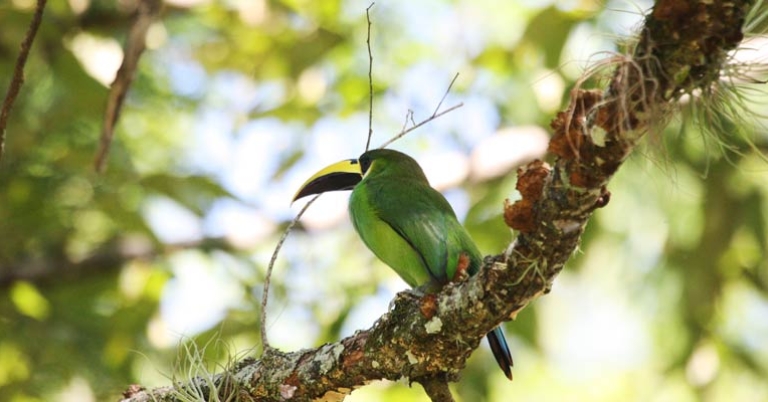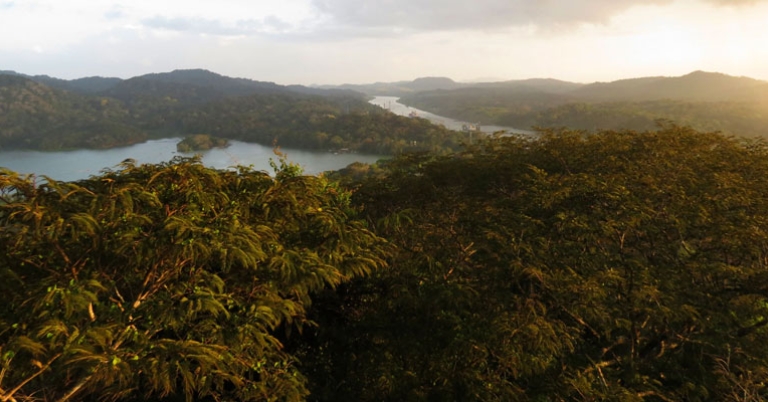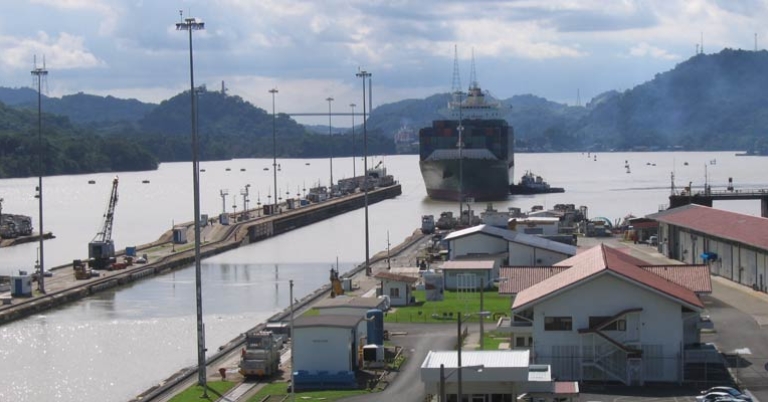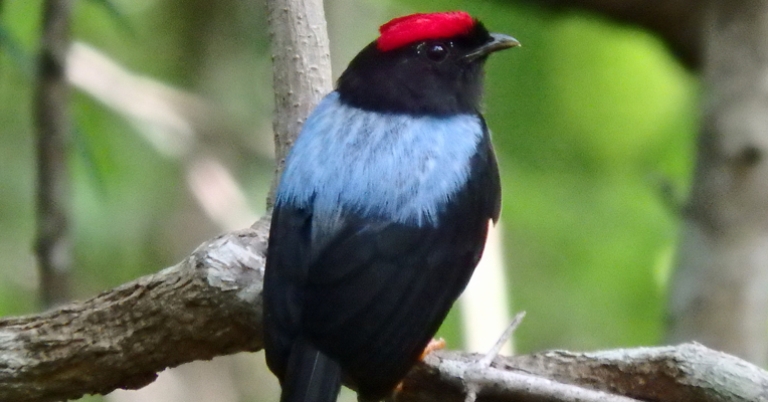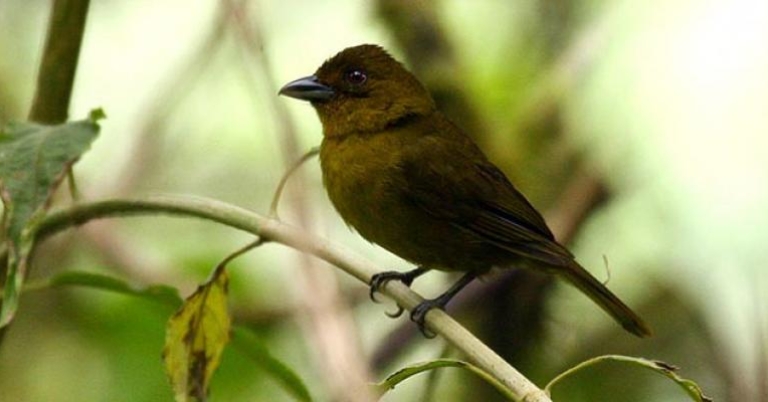Panama | Between Two Continents: Birding in Panama
Date:
Activity Level:
Duration:
Price:
Interests:
About this trip
 When it comes to birds, Panama boasts the highest diversity of species in Central America; the country’s advantageous location at the convergence of two continents makes it the prime respite for migratory birds from both North and South America. Spend time birding in two distinct regions—the tropical rainforests bordering the Panama Canal, and the midlands and highlands of Chiriquí Province in western Panama—for the chance to see a multitude of species at varying elevations. On this 8-day adventure, you’ll explore public and private reserves, visit noteworthy birding hotspots, witness the Panama Canal’s Miraflores Locks in action, and spend eight days immersed in the country’s inviting culture and natural landscapes.
When it comes to birds, Panama boasts the highest diversity of species in Central America; the country’s advantageous location at the convergence of two continents makes it the prime respite for migratory birds from both North and South America. Spend time birding in two distinct regions—the tropical rainforests bordering the Panama Canal, and the midlands and highlands of Chiriquí Province in western Panama—for the chance to see a multitude of species at varying elevations. On this 8-day adventure, you’ll explore public and private reserves, visit noteworthy birding hotspots, witness the Panama Canal’s Miraflores Locks in action, and spend eight days immersed in the country’s inviting culture and natural landscapes.
Highlights
- Hike the world-famous Pipeline Road, where target species include Black Hawk-Eagle, Purple-throated Fruitcrow, Masked Tityra, and hundreds of others.
- Scale the Panama Rainforest Discovery Center’s 130-foot tower for the chance to see upper canopy species, including the coveted Blue Cotinga.
- Search for Resplendent Quetzals in Volcán Barú National Park and on the Pipeline Trail in Boquete, near the border with Costa Rica.
- Visit Panama’s highest elevation natural wetlands at Las Lagunas, 4,000 feet above sea level, where you may see Masked Duck, Chiriquí Yellowthroat, and Crested Guan.
Activity Level 3: Moderate
In a region of birding superlatives, Panama boasts the highest diversity of avian species in all of Central America. Both novice and seasoned birders will appreciate this chance to experience its richest hotspots. Your 8-day itinerary visits two different locations for three nights each, followed by one night in Panama City. Daily birdwatching excursions traverse lowland tropical rainforest, highland montane forests, and wetlands for 2 to 3 hours at a time. The longest walk is four miles along a paved, mainly flat road. Other trails have inclines and can be muddy or uneven. At the Panama Rainforest Discovery Center, you can ascend a 130-foot observation tower (172 steps) into the canopy. Panama is warm and humid, with a dry season that runs from December to March, and a longer wet season from mid-March to December. Even during the wet season rains can be short and intermittent, with a lush effect on the landscape and excellent birding. There’s one internal round-trip flight; land transportation is aboard private, air-conditioned motorcoaches.
Meet your leader
 Brian Rapoza
Brian Rapoza
Brian Rapoza has served as Tropical Audubon Society Field Trip Coordinator since joining the society’s board in 2001. In this role, he leads birding field trips throughout Florida, the U.S. and the Neotropics. Brian is the author of “Birding Florida,” a bird-finding guide on more than 200 locations throughout the state. Since 2001, he has also served as the Christmas Bird Count compiler for both Miami and Coot Bay/Everglades National Park.
Brian is a retired environmental science teacher, outreach specialist and internship coordinator. During his tenure with the Miami-Dade County Public School system, dating to 1988, he led thousands of school children on bird-watching expeditions through Everglades National Park and other birding destinations. In 2006, he was named the MAST (Maritime & Science Technology) Academy Teacher of the Year.
He is a returned Peace Corps Volunteer, having served in the Philippines from 1983 to 1985, and is past president of the Returned Peace Corps Volunteers of South Florida. Brian is originally from New Bedford, Massachusetts, attended the University of Massachusetts and graduated in 1980 with a B.S. in Marine Biology.
$3,825
Per person
About this price
Land cost only. Does not include round-trip airfare to and from destination.
Single room supplement $375
What makes us different
Scopes
Wildlife up-close
Service anytime
Top birding guides
Bird-based tourism
Support local communities
Daily Itinerary
Print ItineraryGamboa
Gamboa
Gamboa
Boquete
Boquete
Boquete
Panama City
Departure
Pricing
Print Pricing$3,825
Per person
About this price
Land cost only. Does not include round-trip airfare to and from destination.
Single room supplement $375
What's Included
- Airport transfers
- Activities and meals as mentioned in itinerary
- Full time expert birding naturalist guide for duration of program
- Private transportation and driver for the duration of the program
- Internal flights relevant to itinerary
- All Tips except Guide and Driver
- Non alcoholic beverage with meals
- Carbon Offset
What's Not Included
- International flights
- Items of personal nature
- Tips for guide and driver
- Trip cancellation coverage
Pricing Details
A deposit of $350 is required for participants to register and reserve space on the program. Reservations submitted beyond the final payment deadline noted below will require full payment to enroll. 120 or more days before departure: $100 cancellation fee; remaining balance is refunded. 119 - 96 days before departure: full deposit of $350 is forfeited. 95 - 0 days before departure: 100% of program price is forfeited.
Holbrook Travel strongly recommends the purchase of travel protection for medical emergencies while traveling and to protect your investment. Please note the purchase of Cancel for Any Reason Coverage or to exclude pre-existing conditions with Trip Cancellation coverage may require policy purchase within 10-14 days of your initial deposit, depending upon the provider.
Single room supplement $375
Final payment due date: December 16, 2025
Travel Info
Print Travel InfoEntry & Exit Requirements
U.S. citizens must have a valid passport to enter Panama. Passports must be valid for at least three months after the date of entry.
A visa is not required for visits up to 180 days.
If you are not traveling with a U.S. passport, please check with the Panamanian Embassy for the requirements based on your nationality.
U.S. citizens entering Panama by commercial flight may be charged a $5 tourist fee if Holbrook does not make your air reservations.
Health Information
IMMUNIZATIONS
The Centers for Disease Control recommends that all travelers be up to date on routine vaccinations such as measles-mumps-rubella (MMR) vaccine, diphtheria-pertussis-tetanus vaccine, varicella (chicken pox) vaccine, and your yearly flu shot before every trip.
There are no vaccinations required for entry into Panama unless you are arriving from a country where yellow fever transmission is a risk.
Yellow fever is a risk in certain parts of Panama, primarily east of the area surrounding the Panama Canal. The CDC recommends the yellow fever vaccine if you are traveling to these areas. Consult your physician for more information.
Though not required, the CDC recommends inoculation against hepatitis A, hepatitis B, and typhoid for most unvaccinated travelers to Panama.
Please consult your physician for additional information and recommendations based on your individual circumstances.
MALARIA
The CDC warns that travelers to certain areas of Panama may be at risk for exposure to malaria. Malaria is caused by a parasite found in Anopheles mosquitos, which are active from dusk until dawn. There is no vaccine to protect against malaria. If you are visiting areas where malaria is present and choose to use an anti-malarial drug, as recommended by the CDC, see your doctor for a prescription. To protect against mosquitos, cover exposed skin with lightweight, long-sleeved shirts and pants, consider treating clothes with permethrin, and use an insect repellent containing an active ingredient like DEET or picaridin.
DENGUE FEVER & OTHER INSECT-BORNE ILLNESSES
Locally transmitted cases of dengue fever have been reported in Panama. Local transmission means that mosquitoes in the area have been infected with dengue and are spreading it to people. In addition, locally transmitted cases of Zika virus, leishmaniasis, and other insect-borne illnesses have previously been reported in Panama.
The CDC recommends that travelers to Panama protect themselves against insect bites. As a precaution, the CDC advises women who are pregnant to consider postponing travel to any area where Zika virus transmission is ongoing.
SUN EXPOSURE
The effects of the sun can be damaging to the eyes and skin. Spending time outdoors exposes you to the sun’s harmful ultraviolet (UV) rays, even on cloudy days. To protect yourself from the sun, use a broad spectrum sunscreen of at least SPF 15, protect skin with clothing, wear a wide-brimmed hat and sunglasses, and drink plenty of fluids.
Respiratory Illness Protocols
Please review our Respiratory Illness Protocols page, which explains our policy and procedures if you or another traveler should develop symptoms of a respiratory illness during your trip. Your participation in a Holbrook Travel program indicates that you are in agreement with these protocols.
Resources
Print ResourcesSuggested Packing List
Everyone has personal preferences when it comes to packing; for this reason, the information below is offered as a general guide and not a definitive list. You know yourself best: Use your discretion and pack what you think will serve you, based on your personal preferences and specific itinerary. You may find many of these items in our Gear Store.
CLOTHING
Casual, comfortable clothing is suitable for most activities. You may wish to bring a slightly nicer outfit or two (eg sundress, polo shirt) if your itinerary includes dinners out or more formal activities. Bring enough clothing suitable for the length of your program. If you prefer to pack light, note that many hotels offer laundry services at additional cost. If you plan to hand-wash items, remember that humidity may delay drying time. Pack clothing that can be worn in layers to adapt to weather changes throughout the day. Clothing that wicks away moisture and dries quickly is recommended.
- A combination of short-sleeved and lightweight, long-sleeved shirts for sun and mosquito protection
- Shorts
- Lightweight, quick-drying long pants for sun and mosquito protection; jeans tend to be uncomfortable in hot and humid conditions, but are fine in the cooler highlands.
- Undergarments
- Sleepwear
- Lightweight jacket or sweater/sweatshirt (or heavier weight if visiting high-elevation areas)
- 1-2 bathing suit(s) for the beach, if applicable, plus many hotels have pools
- Socks – Bring extra pairs. If your itinerary indicates muddy hikes with rubber boots provided on-site, pack a few pairs of knee socks to prevent blisters.
- Shoes – Consider your specific itinerary when choosing footwear. For most programs, you’ll likely want at least one pair of comfortable, closed-toe walking or hiking shoes suitable for forest hikes and walking over cobblestones or other uneven terrain. Sturdier hiking boots may be appropriate for more rugged itineraries. In addition, many participants opt for a pair of sturdy sport-strap sandals (e.g. Keens, Tevas, or similar) and/or casual flip-flops or sandals. If you’re whitewater rafting or visiting the beach, you may also want a pair of aqua socks, reef walkers, or water shoes.
- Lightweight rain jacket, hooded poncho, and/or windbreaker
- Visor or wide-brimmed sun hat
- Bandana, scarf, or Buff-style headwear
MISCELLANEOUS
Remember to pack valuables such as your passport, cash/credit cards, and medications in your carry-on luggage.
- Personal toiletries
- Passport and photocopies of all travel documentation
- Personal insurance card and travel insurance information
- Money – ATM/credit card, traveler's checks, and/or cash; small bills in good condition are recommended
- Prescription medicines (if applicable), with a copy of the prescription
- Yellow fever certificate (if required; only if arriving from a country where yellow fever transmission is a risk)
- Sunglasses with strap
- Small day pack for hikes and excursions
- Flashlight and/or head lamp
- Travel alarm clock or inexpensive waterproof wristwatch with alarm – Not all hotels provide alarm clocks.
- A pocket calculator or phone to assist with conversions and currency exchange
- Binoculars with lens cleaner
- Camera and related equipment, such as charger, lenses, and extra memory cards
- Reusable water bottle
- Non-perishable snacks
- Pocket-knife or multipurpose tool - Pack in your checked luggage
- Zip-top style bags – useful for packing toiletries, sorting clothing, storing damp or muddy shoes, or as a dry bag for protecting electronics
- Notepad or travel journal and pen
- Music or reading material for down time, long bus drives, or on the airplane, and a portable bright light to read by
- Collapsible walking stick with rubber tip
- A small quantity of laundry detergent if you’ll be washing clothing by hand
- Travel-size umbrella – Some people find this unwieldy to carry, while others find it offers better protection than a rain jacket alone.
- Money belt
- Chargers for electronics
In addition to your personal toiletries, it is useful to pack a small medical kit, which you can easily prepare. Helpful items might include: bandages, antihistamine, a pain reliever, motion sickness and/or altitude sickness medication (if you are prone to either), anti-diarrhea medicine, individually wrapped pre-moistened towelettes and/or hand sanitizer, antibiotic ointment, anti-fungal cream, moleskin for blisters, eye drops, tweezers, a mini sewing kit, and an extra pair of disposable contact lenses or eyeglasses if you wear them.

Questions
Contact Jill Hays at 877-846-6296 or jill@holbrooktravel.com.

